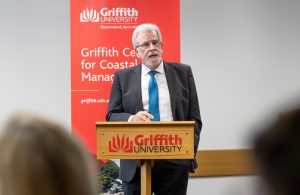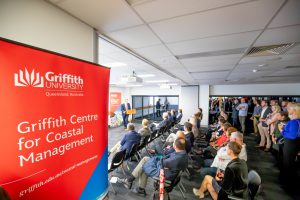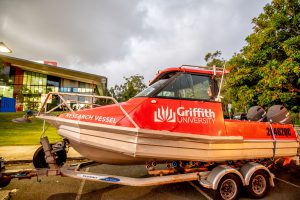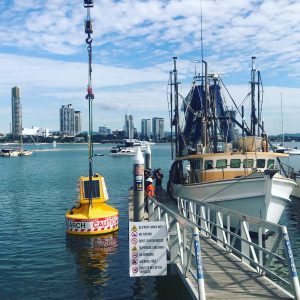Industry stakeholders and researchers gathered to commemorate 20 years of Griffith University’s coastal management expertise in protecting and enhancing the Gold Coast’s iconic shoreline.
The Griffith Centre for Coastal Management (GCCM) has played an integral role in building the Gold Coast’s resilient coastal community through targeted research as well as community and stakeholder engagement in the face of extreme weather events, urban pressures and climate change.

Credit: Luke Marsden
Director Prof Rodger Tomlinson said GCCM had achieved much since its launch in 1999, with thecentrehoused at the Griffith’s Gold Coast campus south of the Smith St Motorway.
“Coastal communities face many challenges, with the greatest being natural hazards such as storms, cyclones and subsequent beach erosion,” he said.
“GCCM has developed a national and international reputation for undertaking targeted research that contributes to all aspects of sustainable management of coastal regions, particularly for urban environments.
“A major focus is on research of relevance to local authorities and the Centre delivers a core program of research in partnership with the City of Gold Coast.”
In 2006, the City of Gold Coast engaged GCCM to develop the Shoreline Management Plan. A strategy with a 50-year horizon, the Plan focuses on coastal physical and ecological processes, economic and community values, and beach management.

Credit: Luke Marsden
At its heart, the Plan aims to keep sand on thebeachesso the tourists keep coming, and prevent erosion from threatening infrastructure when wild weather arrives.
GCCM also facilitates the Coastal Community Engagement Program in partnership with City of Gold Coast.
While boosting community awareness of coastal management, the Program also gives residents opportunities to care for their local beach environments through planting native dune species, weed removal, litter collection and auditing.
GCCM’s major partners include:
- City of Gold Coast
- Gold Coast Water & Waste
- NSW Department of Industry
- Gold Coast Waterways Authority
- International Coastal Management Pty Ltd
- Sunshine Coast Regional Council
- Noosa Shire Council
- SPEL Environmental
Among GCCM’s community affiliations and committee memberships are:
- Friends ofCurrumbin
- Gold Coast Catchment Association
- World Surfing Reserve (WSR) Local Stewardship Committee (LSC)
- Australian Coastal Society
- Healthy Land and Water

Credit: Luke Marsden
With 80% of Australians living by the coast, Pro-Vice Chancellor Griffith Sciences Professor Andrew Smith highlighted the importance of GCCM’s role in developing adaptation strategies for coastal cities to cope with climate change and extreme weather events.

The ‘Big Bird’ research platform.
“We need to understand how to make our cities and coastal communities better adapted to these threats,” Prof Smith said.
“Gold Coasters may remember that we dodged a bullet earlier this year with Cyclone Omar, which fortunately stayed 700km out to sea but did coincide with the King Tides.
“Ongoing research by GCCM plays an important role in helping to tackle the problems of coastal erosion, inundation and in developing more effective long-term management strategies.
“This helps reduce future costs and brings significant long term social, environmental and economic outcomes.”
In May, GCCM launched ‘Big Bird’, a large yellow research platform off South Stradbroke Island on the Gold Coast, to monitor the impacts of wild weather and climate change. And a new radar installation at the Sea Way measures wavebehaviour, sending back huge amounts of data to be interrogated using Big Data Techniques.
GCCM will also take part in Griffith Sciences’ upcoming discussion panelSea Cities: maintaining the balance between urban expansion and natural opportunities.
